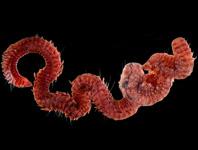Abstract
Micropygomyia (Coquillettimyia) nahua sp. nov., is described and illustrated based on male and female characteristics. Specimens were collected in the Municipality of Naolinco, state of Veracruz, Mexico. This new species of phlebotomine sand fly has characteristics corresponding to the series vexator Fairchild of Galati, with male similar to Micropygomyia (Coquillettimyia) apache (Young & Perkins), Mi. (Coq.) oppidana (Dampf) and Mi. (Coq.) vexator (Coquillett), but recognized by the male paramere structure and simple apex of aedeagal ducts in the male, the later exception for this species series. Female can be confused with Mi. (Coq.) vexator, Mi. (Coq.) oppidana and Mi. (Coq.) apache, but is distinguishable by the cibarial armature combined with the long and very slender individual spermathecal ducts. Keys for male and female species of Micropygomyia (Coquillettimyia) are provided.
References
Artemiev, M.M. (1991) A classification of the subfamily Phlebotominae. Parassitologia, 33 (Supplement 1), 69–77.
Barretto, M.P. (1961) Subfamílias e gêneros neotropicais da família Psychodidae Big., 1854 (Diptera). Papéis Avulsos Departamento de Zoologia, São Paulo, 14, 211–225.
Barretto, M.P. (1962) Novos subgêneros de Lutzomyia França, 1924 (Diptera, Psychodidae, Subfamília Phlebotominae). Revista do Instituto de Medicina Tropical, São Paulo, 4, 91–100.
Cazorla, P.D. & Palazzo, J.M.A. (1995) El grupo Vexator Theodor, 1965 (Diptera: Psychodidae, Phlebotominae). Revista de Ecología Latino-Americana, 4, 19–26.
Coquillett, D.W. (1907) Discovery of a blood sucking Psychodidae in America. Entomological News, 18, 101–102.
Dampf, A. (1944) Notas sobre flebotómidos mexicanos. I. Observaciones generales y descripción de dos especies nuevas (Ph. oppidanus y Ph. vindicator), encontradas en la Ciudad de México (Ins., Diptera, fam. Phlebotomidae). Revista de la Sociedad Mexicana de Historia Natural, 5, 237–254.
Dampf, A. (1947) Notas sobre flebotómidos mexicanos. III. Un nuevo flebótomo (P. chiapanensis n. sp.) aparentemente antropófilo. Medicina, México, 27, 179–183.
Fairchild, G.B. (1955) The relationships and classification of the Phlebotominae (Diptera, Psychodidae). Annals of the Entomological Society of America, 48, 182–196.
https://doi.org/10.1093/aesa/48.3.182Fairchild, G.B. & Hertig, M. (1957) Notes on the Phlebotomus of Panama. XIII. The vexator group with descriptions of new species from Panama and California. Annals of the Entomological Society of America, 50, 325–334.
https://doi.org/10.1093/aesa/50.4.325Forattini, O.P. (1971) Sobre a classificação da subfamília Phlebotominae nas Américas (Diptera: Psychodidae). Papéis Avulsos de Zoologia, São Paulo, 24, 93–111.
Forattini, O.P. (1973) Entomologia Médica. 4° Vol. (Psychodidae. Phlebotominae. Leishmanioses. Bartonelose). Editora Edgar Blücher ltda, Editora da Universidade de São Paulo, SP, 658 pp.
Galati, E.A.B. (1995) Phylogenetic systematics of the Phlebotominae (Diptera: Psychodidae) with emphasis on American groups. Boletín de la Dirección de Malariología y Saneamiento Ambiental, 35 (Supplement 1), 133−142.
Galati, E.A.B. (2003) Morfologia e Taxonomia. In: Rangel, E.F. & Lainson, R. (Eds.), Flebotomíneos do Brasil. Editora FIOCRUZ, Rio de Janeiro, pp. 23–175.
Galati, E.A.B., Galvis-Ovallos, F., Lawyer, P., Léger, N. & Depaquit, J. (2017) An illustrated guide for characters and terminology used in descriptions of Phlebotominae (Diptera, Psychodidae). Parasite, 24, 1–26.
https://doi.org/10.1051/parasite/2017027Ibáñez-Bernal, S. (2003) Phlebotominae (Diptera: Psychodidae) de México. IV.- Las especies de Lutzomyia (Psychodopygus) Mangabeira, de Lutzomyia (Micropygomyia) Barretto, Lutzomyia grupo Oswaldoi, L. (Helcocyrthomyia) Barretto y especies del género sin agrupar. Folia Entomologica Mexicana, 42, 109‒152.
Ibáñez-Bernal, S. (2005) Phlebotominae (Diptera: Psychodidae) de México. V. Clave ilustrada para la identificación de machos de Lutzomyia França. Folia Entomologica Mexicana, 44, 49−66.
Ibáñez-Bernal, S. & Ibarra-Juárez, L.A. (2016) Notes on phlebotomine sand flies of Michoacán, Mexico, with a key for the identification of species currently recorded from this state (Diptera: Psychodidae). Acta Zoológica Mexicana, New Series, 32, 49–54.
Ibáñez-Bernal, S., Muñoz, S., Rebollar-Téllez, E.A., Pech-May, A. & Marina, C.F. (2015) Phlebotomine sand flies (Diptera: Psychodidae) of Chiapas collected near the Guatemala border, with additions to the fauna of Mexico and a new subgenus name. Zootaxa, 3994 (2), 151–186.
https://doi.org/10.11646/zootaxa.3994.2.1
INAFED (Instituto Nacional para el Federalismo y el Desarrollo Municipal) (2017) Naolinco. Enciclopedia de los Municipios y Delegaciones de México. Estado de Veracruz-Llave. Available from: http://www.inafed.gob.mx/work/enciclopedia/EMM30veracruz/municipios/30112a.html (accessed 14 April 2017)
Lewis, D.J., Young, D.G., Fairchild, G.B. & Minter, D.M. (1977) Proposals for a stable classification of the Phlebotomine sandflies (Diptera: Psychodidae). Systematic Entomology, 2, 319–332.
https://doi.org/10.1111/j.1365-3113.1977.tb00381.xMangabeira Filho, O. & Galindo, P. (1944) The genus Flebotomus in California. American Journal of Hygiene, 40, 182–199.
Martins, A.V., Williams, P. & Falção, A.L. (1978) American sand flies (Diptera: Psychodidae, Phlebotominae). Academia Brasileira de Ciências, Rio de Janeiro, 195 pp.
Piña Chan, R. (1960) Mesoamérica. Ensayo Histórico Cultural. Memorias VI. Instituto Nacional de Antropología e Historia (INAH). Secretaría de Educación Pública (SEP), México, 178 pp.
Shimabukuro, P.H.F., Andrade, A.J. & Galati, E.A.B. (2017) Checklist of American sand flies (Diptera, Psychodidae, Phlebotominae): genera, species, and their distribution. ZooKeys, 660, 67–106.
https://doi.org/10.3897/zookeys.660.10508
Steyskal, G.C. (1979) Lutzomyia vexator (Coquillett) the correct designation for Lutzomyia vexatrix of authors (Diptera, Psychodidae). Proceedings of the Entomological Society of Washington, 83, 423.
Theodor, O. (1965) On the classification of American Phlebotominae. Journal of Medical Entomology, 2, 171–197.
https://doi.org/10.1093/jmedent/2.2.171Young, D.G. & Duncan, M.A. (1994) Guide to the identification and geographic distribution of Lutzomyia sand flies in Mexico, The West Indies, Central and South America (Diptera: Psychodidae). Memoirs of the American Entomological Institute, 54, 1–881.
https://doi.org/10.21236/ADA285737Young, D.G. & Perkins, P.V. (1984) Phlebotomine sand flies of North America (Diptera: Psychodidae). Mosquito News (Journal of the American Mosquito Control Association), 44, 263–304.

